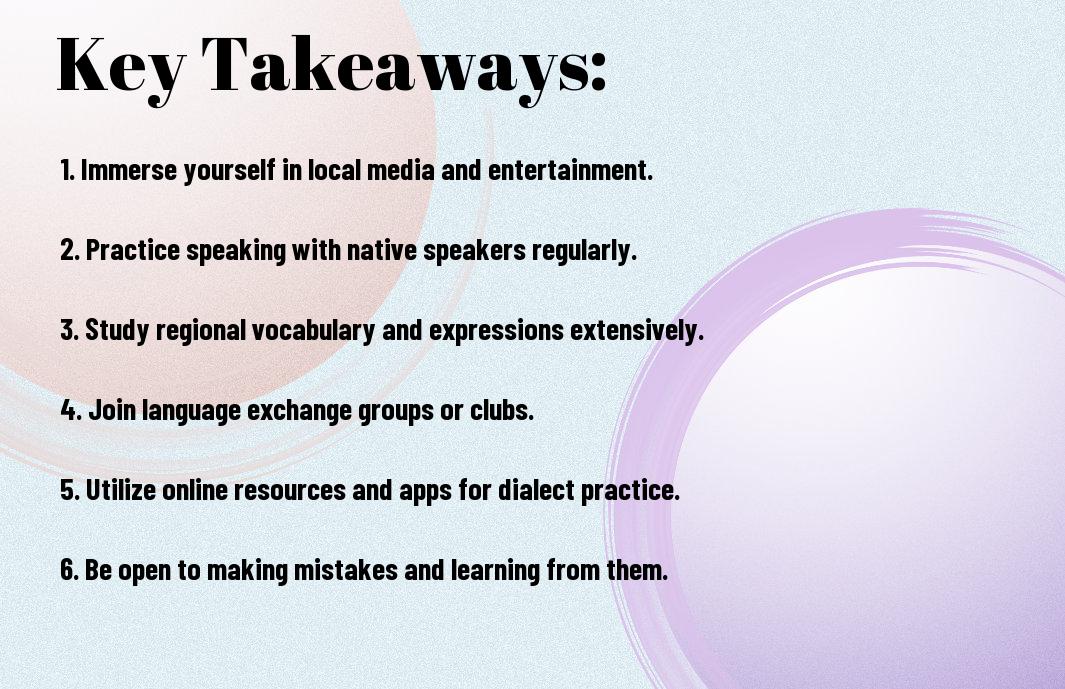As you explore a new language, you’ll discover that dialects vary greatly from region to region. Your language learning journey will be more effective if you focus on the dialect spoken in your desired location. You will gain a deeper understanding of the local culture and enhance your communication skills by learning regional dialects. By following the right approach, you can master the nuances of regional dialects and improve your overall language proficiency.

Key Takeaways:
To effectively learn regional dialects of a language, consider the following points:
- Immerse yourself in the local culture by listening to music, watching movies, and engaging with native speakers from the specific region you’re interested in.
- Focus on phonetic differences and vocabulary variations that distinguish one dialect from another, as these can significantly impact communication and understanding.
- Practice active listening and try to mimic the pronunciation and intonation patterns of native speakers to improve your speaking skills in the dialect.
- Seek out language exchange partners or tutors who are familiar with the dialect you want to learn, as they can provide personalized feedback and guidance.
- Be patient and persistent in your efforts, as learning a regional dialect can be a challenging but rewarding experience that enhances your overall language proficiency and connection to the local community.
Preparation
Before venturing into learning regional dialects, you need to understand the importance of preparation. You must assess your current language skills and identify the dialects you want to learn. This will help you create a focused learning plan, tailored to your needs and goals.
Setting goals for dialect learning
Among the first steps in learning a dialect, you’ll need to set specific, achievable goals. You should consider what you want to accomplish with your newfound dialect skills, such as communicating with native speakers or understanding local media. This will help you stay motivated and directed throughout the learning process.
Finding resources for dialect study
Before starting your dialect learning journey, you’ll need to find reliable resources. You can look for language learning apps, online courses, or language exchange programs that cater to your desired dialect. This will provide you with a solid foundation for your studies.
At this stage, you’ll have access to a wide range of materials, including audio and video recordings, textbooks, and online forums. You can use these resources to learn the unique grammar, vocabulary, and pronunciation of your target dialect, and practice your skills with native speakers or language exchange partners. You’ll be able to immerse yourself in the dialect and gain a deeper understanding of the language and its cultural context.

Immersion
Some of the most effective ways to learn regional dialects involve surrounding yourself with the language, which can be achieved by visiting the official Dialect Differences webpage to get insights on language variations.
Surrounding yourself with native speakers
Yourself immersed in the dialect, you’ll start picking up nuances and expressions that are unique to the region, allowing you to develop a more authentic accent and understanding of the language.
Engaging with local media and culture
Against the backdrop of local traditions and customs, you’ll find that engaging with local media, such as TV shows, movies, and music, can help you get a feel for the dialect and its idiomatic expressions.
Understanding the local media and culture will help you to better grasp the dialect’s context and usage, enabling you to use the language more effectively in everyday conversations, and as you continue to immerse yourself in the language, you’ll become more comfortable with its unique characteristics and rhythms, ultimately improving your overall language skills.
Language Patterns
Your ability to learn regional dialects of a language depends on understanding its unique patterns, including grammar, vocabulary, and pronunciation.
Identifying unique dialectical features
Identifying distinct characteristics of each dialect will help you recognize and replicate them, enabling you to communicate more effectively with native speakers.
Practicing pronunciation and intonation
Pattern recognition is key to mastering dialects, and you can achieve this by listening to and mimicking native speakers, focusing on pronunciation and intonation.
Intonation is a vital aspect of dialects, and as you practice, you will become more aware of the subtle variations in pitch and tone that distinguish one dialect from another, allowing you to convey meaning and emotions more accurately.
Vocabulary Building
Unlike other aspects of language learning, vocabulary building for regional dialects requires a nuanced approach, as you’ll encounter unique words and phrases that may not be used in standard language instruction.
Learning regional expressions and idioms
Vocabularily, you’ll find that regional dialects have distinct expressions and idioms that are imperative to mastering the dialect, and you can learn these by listening to native speakers and engaging with local media.
Expanding vocabulary through context
Idiomatically, you’ll discover that context plays a significant role in understanding regional vocabulary, and you can expand your knowledge by reading local literature, watching regional TV shows, and participating in conversations with native speakers.
Building on your knowledge of regional vocabulary, you’ll find that understanding the context in which words and phrases are used is key to effective communication, and you can achieve this by immersing yourself in the dialect, either by living in the region or engaging with authentic materials, allowing you to develop a deeper understanding of the language and its nuances, and enabling you to express yourself more accurately and confidently in your target dialect.
Practice and Feedback
Keep practicing your regional dialect by engaging with native speakers and seeking feedback on your progress, as this will help you refine your skills and gain confidence in using the dialect.
Engaging in conversations with native speakers
Alongside other language learners, you can find native speakers to converse with, either in person or online, which will help you get accustomed to the dialect’s nuances and pronunciation.
Receiving feedback and correcting mistakes
Besides improving your speaking skills, receiving feedback from native speakers will also help you identify areas where you need to focus your efforts to master the regional dialect.
Feedback is necessary to your growth as you learn a regional dialect, and you should use it to adjust your pronunciation, vocabulary, and grammar, allowing you to sound more natural and authentic in your use of the dialect, and you will find that your skills improve significantly over time with consistent practice and feedback.
Cultural Context
All language learners know that understanding the cultural context is vital to mastering regional dialects. You will gain a deeper understanding of the language and its nuances by studying the culture.
Appreciating the history and customs of the region
Prior to entering into a regional dialect, you should investigate the local history and customs that have shaped the language, allowing you to better understand the dialect’s unique characteristics and expressions.
Avoiding cultural miscommunication
Along with learning the dialect, you must also be mindful of cultural differences to avoid misunderstandings, as certain words or phrases may have different connotations in different regions, and you will need to be sensitive to these differences.
Avoiding cultural miscommunication requires you to be aware of the local norms and values, and to approach language learning with an open mind and a willingness to learn from your mistakes, allowing you to navigate complex cultural situations with confidence and precision, and to effectively communicate with native speakers in their regional dialect.
To wrap up
To wrap up, you have now gained insight into the process of learning regional dialects of a language. As you proceed with your language learning journey, you will need to consider the specifics of the dialects you want to master. You can determine which dialects to focus on by visiting Deciding Which Dialects to Learn to help tailor your learning approach to your goals, and enhance your understanding of the language’s diverse variations, benefiting your overall proficiency.
FAQ
Q: What is the best way to get started with learning regional dialects of a language?
A: To begin learning regional dialects of a language, it’s important to first have a solid foundation in the standard form of the language. Once you have a good grasp of the language basics, you can start exploring the different regional dialects. Start by listening to music, watching TV shows or movies, and talking to native speakers from various regions. This exposure will help you become familiar with the unique sounds, vocabulary, and grammar of each dialect. You can also use online resources such as language learning apps, podcasts, and YouTube channels that focus on regional dialects.
Q: How can I improve my pronunciation when learning a regional dialect?
A: Improving your pronunciation when learning a regional dialect requires practice and dedication. One effective way to do this is to mimic the pronunciation of native speakers. Listen to how they pronounce words and phrases, and then repeat them out loud. You can also record yourself speaking and compare your pronunciation to that of a native speaker. Additionally, focus on learning the specific intonation patterns, rhythm, and stress of the dialect, as these can vary significantly from the standard language. Practice speaking with native speakers as much as possible, and don’t be afraid to make mistakes – it’s all part of the learning process.
Q: Are there any specific tips for learning regional dialects when you’re not immersed in the culture or don’t have access to native speakers?
A: While being immersed in the culture and speaking with native speakers is ideal, it’s not always possible. In this case, there are still several ways to learn regional dialects. You can use online language exchange websites or social media platforms to connect with native speakers and practice your language skills. You can also use language learning software or apps that include regional dialects, such as Rosetta Stone or Babbel. Furthermore, look for online forums or communities dedicated to language learning, where you can ask questions and get feedback from others who are also learning the dialect. Lastly, try to find local language meetups or cultural events in your area, where you can meet people who speak the dialect and practice your language skills in person.

